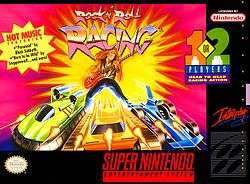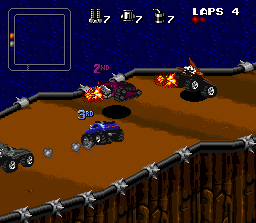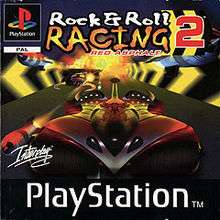Rock n' Roll Racing
| Rock n' Roll Racing | |
|---|---|
 Cover art of Rock n' Roll Racing | |
| Developer(s) |
Additional work by:
|
| Publisher(s) | |
| Composer(s) |
SNES version Tim Follin Geoff Follin GEN/MD version Tony Williams |
| Platform(s) | Super NES, Mega Drive/Genesis, Game Boy Advance |
| Release | |
| Genre(s) | Racing |
| Mode(s) | Single-player, multiplayer |
Rock n' Roll Racing is a vehicular combat-based racing video game developed by Silicon & Synapse (now known as Blizzard Entertainment) and published by Interplay for the Mega Drive/Genesis and the Super Nintendo Entertainment System in 1993. The game prominently features a number of popular heavy metal and rock songs in its soundtrack, hence the game's title. The game was ported to the Game Boy Advance in 2003.
Rock n' Roll Racing was initially developed as RPMII, a sequel to the company's SNES game RPM Racing. At the end of the project, Interplay marketing added licensed music and changed the name to Rock n' Roll Racing. It is also similar in gameplay to Racing Destruction Set where it got its logic/AI engine and the NES game R.C. Pro-Am developed by Rare in 1988.
Game description
The game pits four racers against each other, with up to two of them being player-controlled and the rest being AI opponents. Each race consists of four laps around tracks viewed from an isometric perspective, which enables players to discern the presence of frequent sloping sections spread throughout the game's various tracks. In addition to navigating the turns, racers must also maneuver hills and dips without falling or jumping over the guard rail at the track's edge.

While it is a racing game, there is heavy emphasis on attacking competitor's vehicles; since the cars always reappear with full health just a few seconds after blowing up, the only "harm" done is falling behind in the race. Players are rewarded with a monetary "attack bonus" each time they provide the finishing blow against another car using their forward or rear weapons (and a similar "lapping bonus" when they gain a full one-lap lead on an opponent during the race). In accordance with the continual destruction and restoration of the racing vehicles, the tracks are littered with mines and health power-ups, as well as money power-ups. Other hazards include oil slicks, snow drifts, and lava, depending on the planet hosting the race.
Players are updated on the race by commentator "Loudmouth Larry" (Larry "Supermouth" Huffman), who makes comments like "The stage is set, the green flag drops!" (or "Let the carnage begin!"), and "Rip: is about to blow!" in an enthusiastic tone at appropriate moments during the race. (There is a slight pause between a character's name and any given phrase, as each name and each phrase is its own sound effect, which can be heard in the F/X screen.)
Between races, players can spend the money they have earned on more advanced equipment for their vehicle (engines, tires, shocks, and shielding) or on increasing their capacity for the frontal weapon (energy blasts or missiles), rear weapon (slip sauce or mines), and turbo boost (jump jets or nitro boosts), each of which can max out at seven. Despite their limited capacity, every vehicle will have its weapon and boost charges replenished at the completion of each lap in a race. Racers can also buy more advanced vehicle models; however, all equipment and weapons upgrades are lost when a new vehicle is purchased.
The first three drivers to complete a race are awarded both money and points according to the final standings. Points are required for advancement to the next racing division or the next planet, with two divisions on each planet. A player who has not obtained enough points during a division's racing season must repeat the division, again starting with zero points, but all changes to the player's money and car remain in effect. In two-player mode, when only one player has sufficient points, the character in charge of advancement asks "Leave your loser friend behind?", allowing the leading player to continue alone by removing the other player from the game. The dropped player can continue from that point later by using their most recent password, once the game is reset.
Passwords
Passwords are given out at the beginning of each new "racing season" (each planet has its own definition of how many races make up a season, but early advancement will automatically start a new season), and they are located at the bottom of the F/X screen (accessible from the menu between races). These passwords are a complex code, consisting of three 4-digit sections, and they dictate everything about the players' progress: the character used, the vehicle type and color, weapons and parts upgrades, racing planet and division, difficulty setting, and money. The Game Boy Advance version of the game uses an EEPROM chip to save the player's progress in lieu of the password system.
The password codes only allow the player to save a maximum of $999,990 (six digits); if there are more than six figures in the bank account, the password truncates the leftmost digits over six (e.g. if there's $1,002,000 when the player quits, there will be only $2,000 when using the password to continue later). Due to the two-player password function, it's possible to "cheat" by entering the same password for both players or by entering passwords for players who were at entirely different points in the game. The password with the lowest difficulty setting and on the earliest planet and racing division will be used as the basis for play from then on, which allows for a Warrior-skill character with a maxed-out vehicle to race against Rookie-class AIs in the Rookie skill mode.
Though a password generator QBASIC program exists, the passwords it creates often result in a glitch, causing the player to race on glitchy planets—that exist only as a bug and can crash the game—after racing on Inferno. In the Rookie skill mode, however, they work perfectly, as long as one doesn't try to take the character beyond the third planet using the password.[2]
A second password generator has been written in JavaScript which limits the available planets to reflect the chosen skill mode while retaining the ability to customize any other aspect of the data stored in the password.[3]
Release
In 2003, Blizzard released an Adobe Shockwave-based demo version of the GBA port featuring one track on its website.[4]
In 2014, a demo version of the game featuring three tracks was added to Battle.net, emulated through ZSNES.[5] This version has all rock music tracks changed to simple MIDI music, because the music license expired.
Reception
GamePro gave the Genesis version a mixed review. They praised the Vs. mode and "rockin'" soundtrack with driving-appropriate tunes, but criticized the weak sound effects and remarked that the graphics and digitized voice are noticeably worse than in the Super NES version.[6]
Rock N' Roll Racing was awarded Best Driving Game of 1993 by Electronic Gaming Monthly.[7]
Sequel

A sequel to the original Rock n' Roll Racing was made for the 32-bit PlayStation console by Interplay. The game was sold in Europe as Rock & Roll Racing 2: Red Asphalt and in the United States as just Red Asphalt. It features a comic book art style in the character's profiles and ending videos, and a system to upgrade each character's driving/combat skills like RPGs.
Motor Rock
Released on December 16, 2013, Motor Rock was developed and published by Yard Team on Steam. It features many elements, including art assets, from the original game, and some additional content. It was originally named Rock and Roll Racing 3D.[8] Development was started in June 2009. The game had an Indiegogo campaign.[8]
As of December 23, 2013, Motor Rock has been pulled from Steam Store due to copyright infringement from Blizzard.[9]
Since then Yard Team sells game Steam keys through their website.
References
- ↑ "Rock 'N Roll Racing". GameFAQs.
- ↑ "Rock 'n' Roll Racing cheats, hints, FAQs". GameWinners.com. Retrieved 2008-12-28.
- ↑ "Rock n' Roll Racing Password Generator". BarcodeBattler.co.uk. Retrieved 2013-05-31.
- ↑ Calvert, Justin (23 June 2003). "Rock 'N Roll Racing demo online". GameSpot. CBS Interactive. Retrieved 2 May 2014.
- ↑ Wawro, Alex (2 May 2014). "Rock n' Roll Racing, The Lost Vikings now free on Battle.net". Gamasutra. Think Services. Retrieved 2 May 2014.
- ↑ "ProReview: Rock n' Roll Racing". GamePro (64). IDG. November 1994. p. 86.
- ↑ "Electronic Gaming Monthly's Buyer's Guide". 1994.
- 1 2 "Rock'n'Roll Racing 3D". Indiegogo. Retrieved 2 May 2014.
- ↑ "Motor Rock AppID: 263260". SteamDB. Retrieved 12 July 2015.
External links
- Rock n' Roll Racing at Blizzard Entertainment
- Rock n' Roll Racing at MobyGames
- Red Asphalt at Allgame